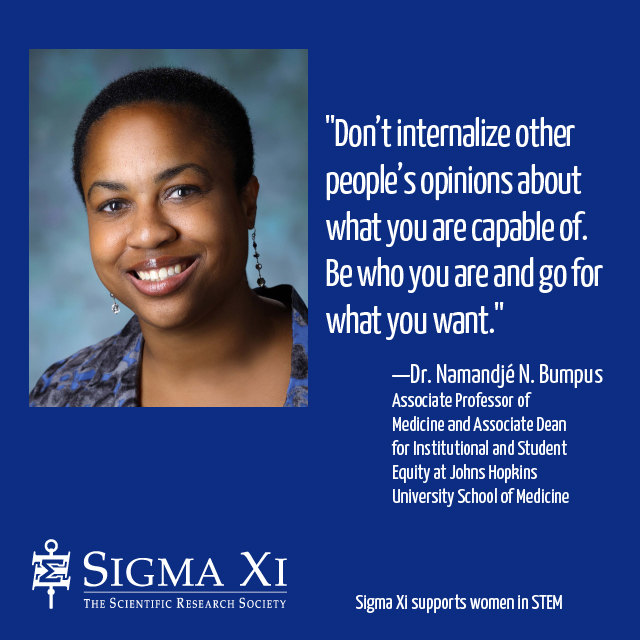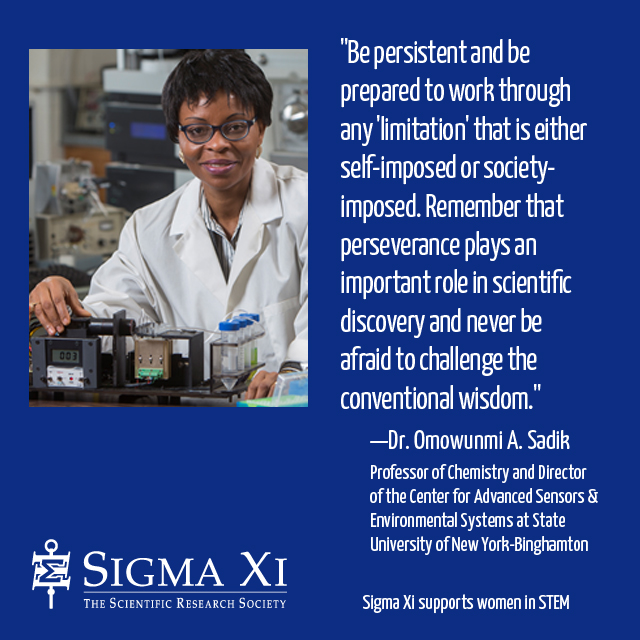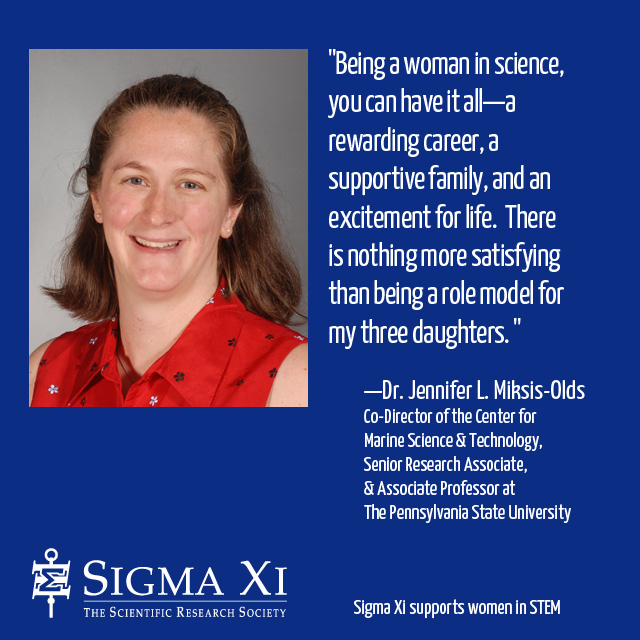Women in STEM: 2016
March is Women's History Month, a time to celebrate the contributions women have made to society. Sigma Xi will participate by celebrating women's contributions to science, technology, engineering, and math (STEM). We asked Sigma Xi members in STEM to share their career experiences and their advice for girls and women interested in STEM.
Dr. Namandjé N. Bumpus

Current position
Associate professor of medicine and associate dean for institutional and student equity at Johns Hopkins University School of Medicine.
Description of your job
I am a pharmacologist. I spend the majority of my effort on research. My lab studies drug metabolism and we focus in particular on how drug metabolism mediates inter-individual variability in anti-HIV drug response. In this role, I mentor graduate students that are pursuing their doctoral research in my laboratory. In addition, I play a role in the mentoring of students more broadly as part of my administrative position working in the area of student equity.
What do you see as your biggest contribution to your field?
Our group has identified mutations in drug metabolizing enzymes that may predispose a person to treatment failure when they are dosed certain anti-HIV drugs.
I work in STEM because...
I love working with students interested in STEM and learning something new every day.
Dr. Tessa M. Hill

Current position
I am an associate professor at UC Davis, in the Department of Earth & Planetary Sciences. Much of my work is based at Bodega Marine Lab, our amazing field station on the Northern California coast.
Description of your job
My job includes many different things! I do field and laboratory research on the impacts of climate change on marine environments in the past and present. One of the best parts of this work is mentoring undergraduates, graduate students, and postdoctoral scholars as they pursue their research and career goals. I also teach oceanography courses at UC Davis, at both the undergraduate and graduate level.
Another really exciting and fundamental part of my job is that I talk to other scientists, and to people outside of the university, about the impact of climate change on the ocean. I also work with future K-12 science teachers to develop climate change curriculum that they can use in their classrooms.
I work in STEM because...
It is exciting and important. I get to ask interesting questions and help chip away at our understanding of big problems.
Dr. Omowunmi A. Sadik

Current position
Professor of chemistry and director of the Center for Advanced Sensors & Environmental Systems at State University of New York-Binghamton
Description of your job
As a professor of chemistry and the director of an organized research center, my job involves teaching, conducting research, and participating in professional services. My teaching includes a wide variety of academic and research subjects; I also conduct research and I publish the results of my research findings in technical journals, which includes scholarly papers and books/book chapters. I give technical lectures worldwide in my areas of expertise. I spend a large portion of my time conducting research and applying for grants to fund my research programs. Specifically, I teach graduate and undergraduate courses in introductory chemistry, quantitative chemical analysis, instrumental analysis, biosensors, and environmental chemistry. Sometimes the enrollments in these classes vary: some are very large with several hundred students and I do this usually with the help of several graduate teaching assistants. Other classes are small comprising about 40–100 students, and sometimes there are graduate classes with just a few students. In addition, I also supervise research laboratories where students work on specialized subjects in my areas of expertise. These include doctor of philosophy (PhD), master of science (MS), and bachelor of science (BS) students.
One aspect of being a professor is that I must keep up with new developments in my research field by reading scholarly articles, and participating in professional conferences, seminars, and workshops.
Regarding professional services, I serve on my university committees, departmental committees, or as a member of the editorial boards of professional journals. Finally I serve as a reviewer of scientific articles submitted to technical journals, and on the review panels/committees for grant applications submitted to funding agencies. I have served in elected positions of scholarly societies.
What do you see as the biggest contribution to your field?
A core objective of my research program is to understand the mechanisms of how chemical information is transformed from one interface to another, and to use that knowledge to develop innovative sensing technologies, functional materials, and devices. We are conducting groundbreaking research in biosensors leading to the development of new diagnostic tools and detection devices for various medical, environmental, and food applications. I have authored or co-authored over 160 scientific publications and I have given over 350 invited lectures and conference contributions worldwide. Some of my publications have appeared in very reputable scientific journals such as Nature Nanotechnology (in review), ACS Nano, RSC Advances, Langmuir, ACS Catalysis, Chemical Communication, and Biosensors & Bioelectronics. I have five U.S. patents as well as other pending patent applications. I successfully led my team of researchers to translate basic research in biosensors into the design and fabrication of a prototype portable, fully autonomous, and remotely operated sensing device known as U-PAC™ (Ultra-Sensitive Portable Capillary Sensor). This devise exhibits superior performance for detecting proteins, nucleic acids, and E-coli with 4-fold lower detection limits than conventional ELISA techniques and the results are displayed within minutes.
I work in STEM because...
I am passionate about using fundamental knowledge of science to solving problems in the broader world around us. Being a university professor provides me the opportunity to impact the development of career scientists—from the crucial undergraduate years through the doctoral and post-doctoral levels. Out of the 30 PhD and MS students that I have mentored to date, 10 have secured faculty positions in leading universities around the world; others are employed in the industries and at national laboratories in the United States. As the president and co-founder of the Sustainable Nanotechnology Organization (SNO), I am also promoting the responsible growth of nanotechnology around the world through research, education, and outreach. Through SNO, I am making science accessible to lay audiences and to those that have traditionally have been excluded from the process of science.
Dr. France A. Córdova

Current position
Director of the National Science Foundation (NSF)
Description of your job
It is a tremendous honor to serve as director of NSF. I was nominated by President Barack Obama to lead the nation’s only federal science agency whose mission covers both education and fundamental research across all fields of science discovery, technological innovation, and science, technology, engineering, and mathematics (STEM) education.
The scope of NSF research is immense and I’m proud to be a part of a legacy that has led to barcodes and Doppler radar, catalogued languages and decoded genomes, and the creation of Google and the internet as we know it. NSF has supported 217 Nobel Prize winners and hundreds of small businesses. It is this kind of support that enhances our nation’s security, drives the U.S. economy, and advances our knowledge to sustain global leadership.
Our mission, first and foremost, is turning the bold ideas of today's scientists into tomorrow's realities. A wonderful example of this is the recent discovery of gravitational waves, detected 100 years after being predicted by Albert Einstein first predicted them. This discovery, made by a NSF-funded facility known as LIGO, and a host of scientists from around the world, opens unprecedented new window to the cosmos.
Top professional accomplishments
I’ve had a long career in academia. I served as president of Purdue University. I also led the University of California, Riverside as chancellor and was a distinguished professor of physics and astronomy.
I served as NASA's chief scientist and won the agency’s highest honor, the Distinguished Service Medal. Before joining NASA, I led the department of astronomy and astrophysics at Pennsylvania State University. I also worked in the Earth and space sciences division at Los Alamos National Laboratory.
More recently, I served as chair of the Board of Regents of the Smithsonian Institution and on the board of trustees of Mayo Clinic. I was also a member of the National Science Board (NSB), where I chaired the Committee on Strategy and Budget.
I received my bachelor of arts degree from Stanford University and my doctorate in physics from the California Institute of Technology. I worked in both observational and experimental astrophysics, as well as multi-spectral research on x-ray and gamma ray sources and space-borne instrumentation, and have published more than 150 scientific papers.
I work in STEM because...
I work in STEM simply because the possibilities, surprises, and rewards are endless. I am driven by possibility, by the chance to discover something new. As a young girl I was enchanted by the mysteries of the night sky, and that early passion eventually lead me to astronomy. I’ve had a handful of life-changing moments as a scientist: the night I launched a rocket payload to detect collapsed stars, the day I saw the telltale signal in my satellite data of the X-ray pulsations of an accreting star. And I’ve had many highlights in my time as NSF director: helping break ground for a new telescope high in the Chilean mountains, touring a high-tech ocean research vessel. But what I enjoy most is talking with students from across the country about their scientific passions and goals. We must support these students, and ensure they represent the diversity of America. The key is to spark curiosity in science and math at an early age, then give woman and girls every opportunity to nurture that curiosity.
Dr. Jennifer L. Miksis-Olds

Current position
Co-director for the Center for Marine Science & Technology at The Pennsylvania State University. I'm also a senior research associate in the Applied Research Laboratory and an associate professor in the Graduate Program in Acoustics at Penn State.
Description of your job
I’m primarily research faculty that teaches a specialty graduate level course every one to two years. I work in the field of bioacoustics which means I use acoustic technology to study life in the ocean. My field is a combination of knowledge from biology, ecology, oceanography, engineering, and physics. Being so interdisciplinary is fun because it allows me to easily communicate with researchers from many different topic areas. I spend four to six weeks at sea each year, which is an exciting break from data analysis in the office. I enjoy working with students and involve both graduate and undergraduate students in my lab. I love my job because I find myself doing different things each day, and I’m constantly learning from my colleagues and students. As co-director of the Center for Marine Science & Technology, I’m tasked with raising the visibility of ocean science within the land-locked community of Penn State and the national science community.
What do you see as your biggest contribution to your field?
My biggest contribution to the field was developing SeaBASS: A Marine BioAcoustic Summer School. Marine bioacoustics is a small but highly interdisciplinary field, and no one university has the in-house expertise to provide a full degree program on this topic. SeaBASS was created as a week-long course to train the next generation of marine bioacousticians. It brings graduate students together with experts in the field for an intensive week of lectures, hand-on activities and demonstrations, networking, career discussions, and socializing. Hearing about SeaBASS students going on to be successful in industry, government, and military science careers is more rewarding than any combination of research publications, book chapters, or successful proposals.
I work in STEM because...
Science challenges me. I get bored easily, and the life-long learning and challenges that research provides continually excites me. For every one question I seek to answer, many more are generated in the research process.
More from the Women in STEM Project
2020
2019
2018
2017
2016
2015
All years